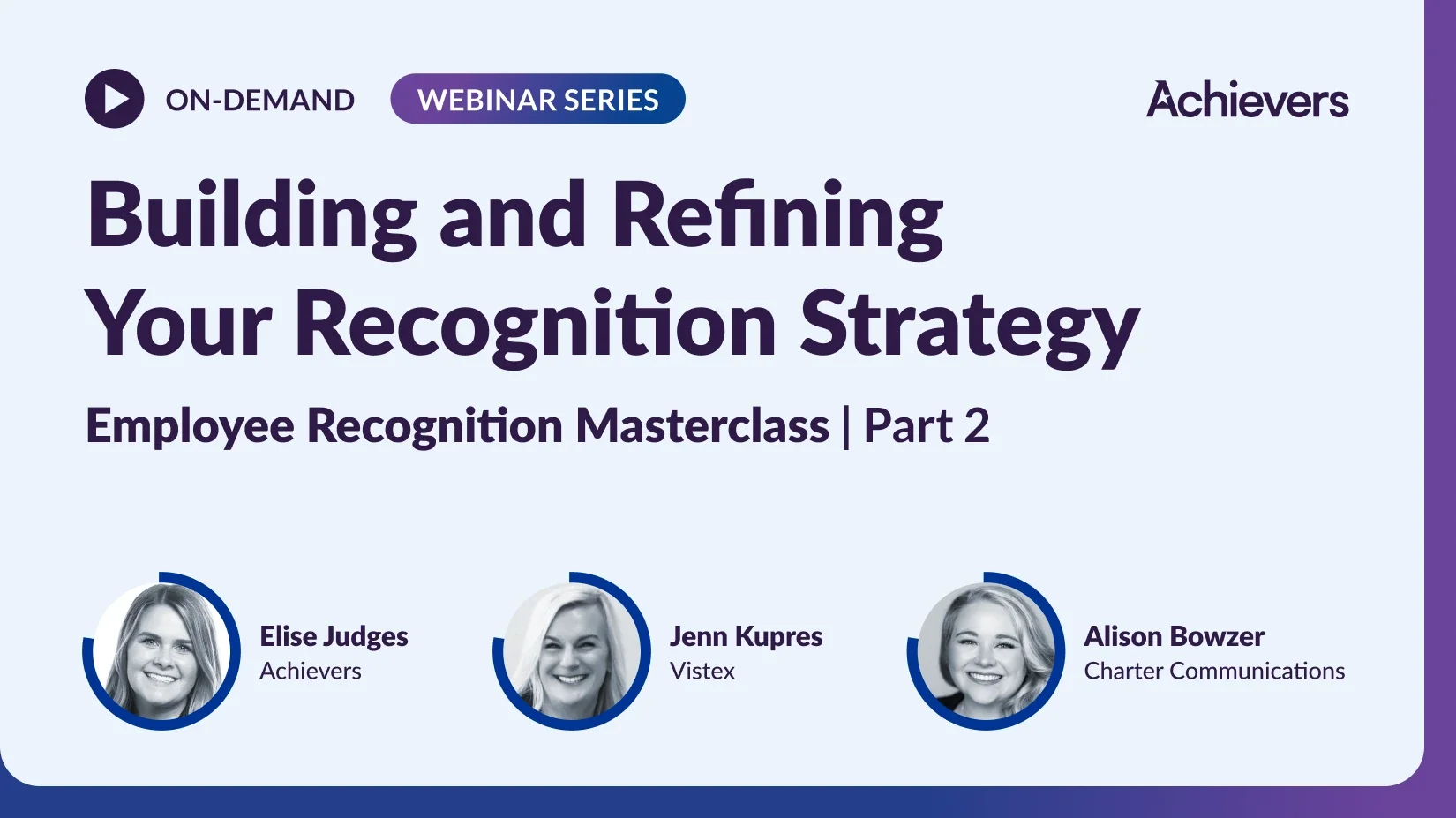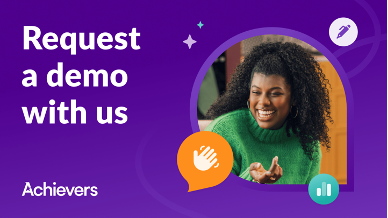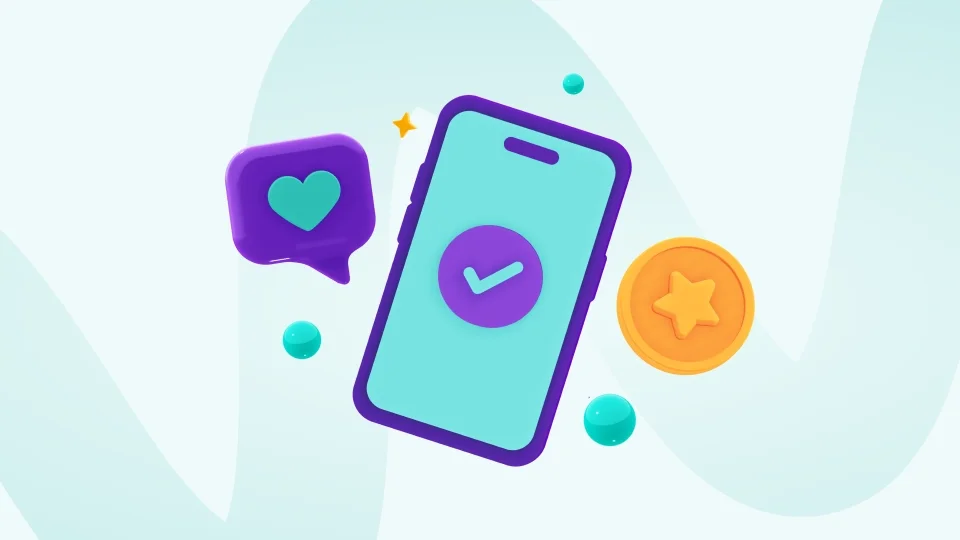Table of contents
Workplaces have changed significantly in recent years, and that means it’s more important than ever to modernize rewards and recognition programs to keep up with today’s workforce dynamics. With hybrid and remote work continuing and new expectations shaping the return-to-work landscape, keeping employees connected and engaged isn’t always easy.
That’s why modernizing these programs is crucial. It requires throwing the old playbooks away and saying goodbye to perks like President’s Club or seasonal gifting. Instead, it’s about building recognition software that creates meaningful change in organizations.
So, how exactly do you modernize rewards and recognition programs? You start by learning what the future of return to work looks like, trends that HR leaders are seeing, and how those trends are shaping today’s workforces. Then, you let Achievers help you start recognizing like it’s 2025 — and watch employee engagement and motivation grow.
The future of work and the role of modernized rewards and recognition programs
The way we work looks much different today than it did years ago. Changes in the economy, labor markets, and employee expectations have led organizations to rethink how they approach their company culture. As return-to-work policies evolve, companies must rethink how they approach recognition to align with the flexibility employees now expect.
At the heart of these changes is the need to modernize rewards and recognition programs, and to ensure they meet current challenges and opportunities. Modernized programs play a key role in building better connections, engagement, and driving productive behaviors.
Remote and hybrid work environments
Remote and hybrid work have opened new possibilities for flexibility, but they’ve also made it harder for employees to feel connected. Without those real-time, in-person moments of employee appreciation, it’s easy for contributions to go unnoticed.
This is where digital, accessible platforms make all the difference. These tools make recognition timely, frequent, and meaningful — whether your team is in the office, at home, or working across multiple locations. They create a culture where every employee feels seen and appreciated, no matter where they work.
A multigenerational workforce
Every workplace includes multiple generations, and each group has different needs when it comes to recognition. Online recognition and rewards platforms are a great way to bridge those gaps, offering flexibility to meet everyone where they are.
According to insights from LinkedIn, younger employees, such as Millennials and Gen Z, are 73% more likely to desire frequent recognition compared to Baby Boomers. Creating a modern recognition platform that accommodates these different preferences can help bridge generational gaps, ensuring that all employees feel valued and appreciated.
Global teams
As teams become more global, recognizing employees across cultures and time zones can feel challenging. What works for one region might not have the same impact as another, so it’s important to adapt recognition efforts to meet those unique needs.
Online recognition platforms help make this easier. They offer flexibility, allowing companies to tailor rewards to local preferences, whether it’s offering region-specific gift cards or experiences that resonate with diverse cultures. Real-time digital recognition also ensures that everyone feels appreciated, no matter where they’re located.
With the right platform, global teams can feel seen and valued, building a stronger sense of connection even when they’re spread across different parts of the world.
What HR leaders are saying about modernizing rewards and recognition
HR leaders understand that the future of work is changing — and quickly. Staying competitive means adapting rewards and recognition programs to meet those changes head-on. With many companies navigating a return to work and adjusting to hybrid environments, modernizing these programs has become essential for engaging employees and ensuring retention.
In fact, insights from AWI’s 2024 State of Recognition Report showed 63% of HR leaders were committed to increasing recognition and reward spend.
Modernizing these programs is no longer optional — it’s necessary, and it requires HR leaders to address the uncertainty many organizations face.
“Unfortunately, 2025 will bring continued, and unprecedented levels of uncertainty in organizations. We cannot afford to shy away, stick our heads in the sand and ignore this challenge, in fact we need to do the opposite, recognize those that are doing good during this time.”
– Hannah Yardley, Chief People and Culture Officer, Achievers
That’s why HR leaders are moving away from one-size-fits-all approaches, like performance-based bonuses, and embracing personalized rewards that cater to individual employees. As remote and hybrid work environments continue to be a regular part of the workforce and HR trends change, digital platforms are key in delivering real-time, accessible recognition, ensuring employees feel seen and appreciated no matter where they work.
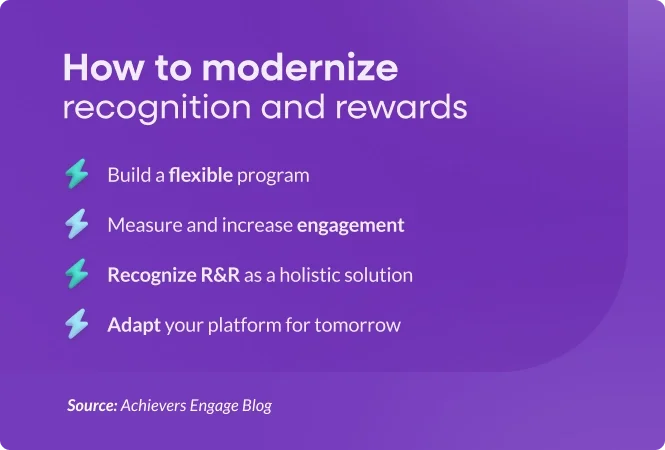
How to modernize rewards and recognition programs
Modernizing rewards and recognition starts with the understanding that today’s workforce is more diverse, dispersed, and digitally connected than ever before. For HR leaders, this means improving the way they recognize in a way that encourages positive behaviors and helps drive both individual and company-wide goals.
In fact, the Achievers Workforce Institute (AWI) 2024 State of Recognition Report found that companies that have an online recognition solution are 2x as likely as those with an in-house program to say their recognition strategies drive business results.
A modern R&R program should adapt to changes without hesitation, be easy to scale, and provide personalized recognition that resonates with employees, no matter where they work or what their interests and passions are. By making these programs more flexible and integrated, businesses can boost engagement and improve retention without losing their competitive edge.
1. Build a flexible and scalable R&R program
The shift to remote and hybrid work, along with changes in return-to-work policies, has reshaped how companies engage with their employees. As organizations adapt to flexible work models, they need rewards and recognition programs to adapt alongside them.
Dynamic and integrated R&R software is essential to address the diverse needs of today’s workforce, promote a sense of connection and belonging, and encourage collaboration across global teams.
Here’s how you can start to build a flexible and scalable program with a rewards and recognition provider:
- Set objectives: Before anything else, think about what you want your R&R platform to achieve. Are you looking to improve employee retention? Are you struggling with culture alignment? Do you know what key performance indicators (KPIs) you’re looking to track? These questions can help craft a program that’s tailored to the needs of your organization and its employees.
- Allocate budget: Recognition isn’t a box you check at the end of the year. It’s an investment in employee retention and productivity. By setting aside a dedicated budget, you show your employees that their contributions are valued year-round and that you care about their success at your company.
- Measure impact: Regularly evaluate the effectiveness of your R&R program. Use feedback tools, engagement metrics, and performance data to adjust recognition strategies and ensure the program matches company goals.
- Offer diverse rewards: In the past, employees might have received a generic branded coffee mug or a seasonal gift as a thank-you from their employers. Today, companies have a chance to tailor their reward offerings to reflect the diverse interests of their employees. It’s this attention to detail that ultimately leads to higher engagement rates, feelings of belonging, and a stronger connection to the company.
2. Understand, measure, and increase engagement
As workforces become more global, organizations need to stay on top of employee engagement, including tracking motivation and productivity to prevent burnout and disengagement. Recognizing employee accomplishments — big or small — and top performers helps maintain employee morale, but it’s just one piece of the puzzle. There’s much more to creating long-term engagement and satisfaction.
To make sure your employee recognition program is working the way it should, you need data to back it up. By using data analytics, AI, and machine learning, HR leaders can get a clearer picture of what drives engagement and where improvements are needed. This helps HR teams personalize recognition, adjust strategies, and measure ROI more effectively.
Once you’ve gathered feedback, you need to do something about it. AWI’s 2024 Engagement and Retention report found that acting on feedback increases trust in company leaders by 75% more than gathering feedback alone. With the right insights and actionable steps in place, engagement skyrockets — and your employees will feel seen, heard, and appreciated.
3. Recognize R&R as a holistic solution for employee experience
The most effective way to modernize rewards and recognition is to think of it as a holistic solution — one that supports employees’ well-being and growth across a range of areas, including physical, emotional, and financial wellness initiatives, alongside opportunities for learning and development.
In fact, career progression continues to be one of the top reasons employees leave their current roles. It’s an important reality to face if employers want to increase employee productivity and retention. People who see promotion equity are more than twice as likely to say they can see themselves having a long career at their company and are almost twice as likely to job hunt.
Recognition plays a significant part in those metrics. When employees see a future at their current workplace, they’re less inclined to look for opportunities elsewhere. By integrating recognition with well-being and development opportunities, companies can create a holistic employee experience that encourages their top talent to stay and thrive exactly where they are.
4. Adapt your platform for tomorrow’s workforce
To stay competitive, an employee rewards platform needs to offer personalized, tailored experiences for employees. Think of it like an online shopping experience: Employees want a wide range of rewards that cater to their tastes, from tangible products to travel perks. A flexible platform with global options keeps employees engaged and happy.
Offering a variety of rewards that employees can personalize ensures inclusivity and allows recognition to feel more intentional and meaningful. This flexibility helps address the different motivations of a workplace, which ultimately drives employee engagement, reduces turnover, and reinforces a strong company culture. When recognition feels personalized, employees are more likely to stay motivated and aligned with organizational goals, creating a more positive and productive workplace overall.
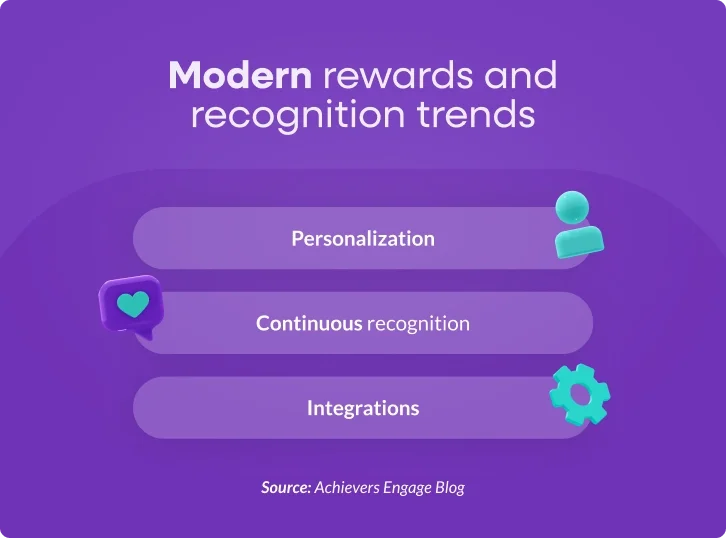
Trends shaping modern rewards and recognition in 2025
Rewards and recognition programs are quickly evolving, and staying ahead means keeping up with the latest trends. In 2025, it’s all about personalization, real-time feedback, and making recognition seamless across HRIS and workplace tools.
Personalization at scale
Expect more companies to move beyond generic one-size-fits-all approaches and create individualized recognition experiences that resonate with employees, helping boost motivation and engagement. By utilizing AI, organizations can personalize the recognition and reward (R&R) experience to the unique interests and wants of individual employees.
Custom recognition messages or tailored rewards allow employees to feel valued in a way that aligns with their interests, making recognition more meaningful.
Continuous recognition
Instead of stagnant annual reviews, 2025 is all about real-time, continuous recognition. Companies are shifting to frequent feedback through engagement surveys and always-on solutions, putting recognition front and center of the conversation.
By offering consistent and timely feedback, employees are more likely to feel acknowledged and connected to their teams. As where and how we work changes, continuous recognition is essential for keeping employees motivated and engaged throughout the year, ensuring they feel connected to their role, their peers, and the goals of the organization.
Integration with employee experience platforms
Modernizing rewards and recognition programs today means integrating tools seamlessly into the platforms employees already use, like Slack or Microsoft Teams. When recognition becomes a natural part of daily workflows, it creates a sense of connection among team members — eliminating the need to open a new browser or app to recognize their colleagues.
By simply integrating recognition into the way your employees work, you can unify the employee experience and maintain consistent data — which gives you the insights you need to drive positive change across your organization.
How to start recognizing like it’s 2025
It’s important for recognition programs to mirror the fast-paced, digitally connected world we work in. Employees want more than just awards and the occasional “thank you” from leadership — they want meaningful, personalized recognition that reflects their contributions and aligns with company values.
These strategies can help modernize rewards and recognition programs in 2025. Here’s how to create an R&R program for your organization that’s ready for the future:
1. Leverage technology
Modern recognition platforms combine AI, automation, and gamification to create personalized experiences. These tools allow organizations to celebrate achievements in real time and offer valuable insights into employee engagement. By embracing technology, you can make recognition seamless, scalable, and deeply impactful.
2. Create a feedback-driven culture
Recognition shouldn’t just come from the top down. Peer-to-peer and upward feedback foster stronger team dynamics and trust. Research from Achievers Workforce Institute found that 42% of employees surveyed were more engaged at work when recognized monthly by their peers, compared to 23% recognized annually or less. When employees are empowered to recognize each other and provide feedback regularly, it reinforces a culture of collaboration and respect.
3. Tie recognition to values
Recognition becomes instantly more meaningful when it connects with what your organization stands for. Celebrate contributions that align with your mission and values. Whether that means spotlighting achievements tied to sustainability, innovation, or customer success, making this connection not only shows you appreciate your employees but also reinforces your company’s culture and priorities.
4. Global reach, local impact
As employees return to work, whether in-person or remotely, global recognition programs can help build and maintain meaningful connections. The key is to create a customized marketplace that offers flexible rewards tailored to your organization’s different regions and cultures. Whether it’s travel experiences or locally sourced items, this inclusive approach helps employees feel valued, regardless of their location or work setup.
Modernize rewards and recognition with Achievers
Ready to transform the way you recognize in 2025? Achievers helps companies around the world build modern R&R programs from the ground up. Whether you’re starting fresh or looking to redefine the way you show up for your employees, Achievers provides tools to drive engagement, build lasting connections, and align recognition with your company’s culture. We combine Achievers Recognize with Achievers Reward to create an all-in-one solution that can be integrated into the HRIS and SaaS programs you use on a daily basis.
With an intuitive design, global reach, and impactful features like always-on feedback and tailored rewards, it supports your workforce’s needs today while laying the foundation for the future.
